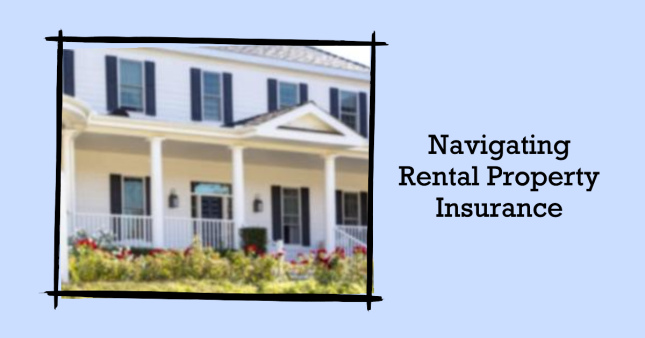Introduction to Rental Property Insurance
Understanding the Essence of Rental Property Insurance
Landlords can use rental property insurance as a safety net, offering coverage for unanticipated occurrences and potential monetary losses on their rental properties. This kind of insurance provides landlords with peace of mind and guarantees that they are ready for any situation, allowing them to concentrate on other facets of property management.

Significance of Comprehensive Coverage for Rental Properties
Rental property insurance must include comprehensive coverage because it protects landlords’ investments from a variety of risks. By selecting the appropriate coverage options, landlords can minimize potential financial losses resulting from property damage, liability claims, loss of rental income, and other unforeseen circumstances. It offers reassurance and acts as a safety net, allowing landlords to protect their assets.
Key Factors Influencing Rental Property Insurance Cost
Determining the cost of rental property insurance involves several key factors that insurance providers consider when calculating premiums. Understanding these factors can help landlords make informed decisions and effectively manage insurance costs.
Property Location and Associated Risks
The location of a rental property significantly impacts insurance costs. Properties situated in areas prone to natural disasters, such as hurricanes, floods, or earthquakes, generally have higher premiums. Conversely, properties located in low-risk areas enjoy lower insurance premiums.
Property Type and Structure
The type and structure of a rental property also play a crucial role in determining insurance costs. Insurance companies take into account things like the type of roof, the materials used in construction, and the overall layout of the property. Properties with durable materials and structures typically incur lower premiums due to their reduced risk of damage.
Age and Condition of the Rental Property
The condition and age of the rental property have an impact on insurance rates because older properties may be more likely to have maintenance problems or out-of-date systems than new properties. In general, premiums are lower for newly constructed or well-maintained properties because they are less likely to experience serious problems.
Security Measures Implemented
By investing in security systems and practices, insurance costs can be decreased. For homes with security features like fire extinguishers, smoke detectors, and burglar alarms, insurance companies frequently offer discounts. The risk that insurance companies perceive decreases with increased security implementation.
Deductibles and Insurance Policy Limits
In order to effectively manage insurance costs, the right deductible and policy limits must be chosen. Despite the fact that higher deductibles are associated with lower premiums, landlords must be prepared to pay a larger portion of the bill in the event of a claim. Assessing the value of the property and its contents can help determine the appropriate policy limits, ensuring adequate coverage without overpaying for unnecessary protection.
Types of Rental Property Insurance
Rental property insurance typically consists of several types of coverage options that landlords can tailor to their specific needs. Understanding each type of coverage ensures comprehensive protection for the rental property and its owner.
Dwelling Coverage: Protecting the Rental Structure
Dwelling coverage focuses on safeguarding the physical structure of the rental property itself. This type of coverage typically includes protection against perils like fire, vandalism, lightning, and windstorms. It ensures that landlords can repair or rebuild their properties in the event of damage caused by covered perils.
Personal Property Coverage: Safeguarding Belongings
Personal property coverage extends protection to the landlord’s personal belongings within the rental property. It covers items like furniture, appliances, and electronics that the landlord has provided for tenant use. The investment that landlords have made in the property’s contents is particularly well protected by this coverage.
Read More: The Tips to Guide You with Homeowners Insurance
Liability Coverage: Shielding Against Lawsuits
In order to shield landlords from potential legal claims, liability coverage is essential. It covers expenses related to bodily injury or property damage caused by the rental property. In the event of a lawsuit, liability coverage provides financial support, including legal fees, settlements, or judgments.
Loss of Rental Income Coverage: Mitigating Financial Losses
Loss of rental income coverage is designed to financially protect landlords when their rental property becomes uninhabitable due to a covered loss. This coverage helps mitigate the financial impact of lost rental income during the repair or rebuilding phase, providing landlords with much-needed support during challenging times.
Additional Coverages and Optional Add-ons
Insurance providers often offer additional coverages and optional add-ons to enhance landlords’ insurance policies. These may include coverage for additional structures on the property, like detached garages or sheds, as well as coverage for specific perils such as earthquakes or floods. Optional add-ons can provide tailored protection based on the landlord’s unique circumstances and needs.
Evaluating Rental Property Insurance Providers
Choosing the right insurance provider is essential to ensuring reliable coverage and efficient claim handling. Conducting thorough research and analysis of potential insurance companies before making a decision is vital.
Researching Reputable Insurance Companies
Begin by researching reputable insurance companies that specialize in rental property insurance. Look for companies with a solid track record, positive customer reviews, and reliable customer service. Utilize online resources, industry publications, and recommendations from trusted sources to identify top insurance providers.
Read Related Post: Innovative Ways to Boost Retirement Income
Comparing Quotes and Policy Offerings
Obtain quotes from multiple insurance companies to compare their offerings. When evaluating quotes, consider the coverage options, deductibles, premiums, and any additional benefits offered. Pay attention to the overall value provided by each policy rather than solely focusing on the price.
Assessing Financial Stability and Claims Handling
Assess the financial stability of insurance companies by reviewing their ratings from reputable rating agencies. A financially stable insurer is more likely to honor policy claims promptly. Additionally, consider the insurer’s reputation for claims handling. Look for companies with a reputation for efficient and fair claims processes.
Understanding Policy Exclusions and Limitations
Thoroughly review the policy documents and understand the exclusions and limitations of coverage. It is essential to have a clear understanding of what is covered and what is excluded to avoid any surprises in the event of a claim. If certain coverages or conditions are important to the landlord, ensure they are explicitly included in the policy.
Determining the Cost of Rental Property Insurance
Accurately determining the cost of rental property insurance involves a comprehensive assessment of various factors that can affect premiums. Understanding these factors is essential for landlords to make informed decisions when selecting coverage.
Obtaining Accurate Insurance Estimates
Obtain accurate insurance estimates by providing detailed information about the rental property to insurance providers. This includes specifics such as the property’s location, structural details, security measures, and the landlord’s desired coverage options. The more accurate the information provided, the more precise the estimates will be.
Factors That Can Reduce Insurance Premiums
Several factors can help reduce insurance premiums. Implementing security measures such as installing security systems, smoke detectors, and fire extinguishers can result in premium reductions. Choosing higher deductibles and bundling multiple insurance policies with the same provider are other tactics to consider.
Common Mistakes to Avoid While Assessing Costs
Landlords should avoid common mistakes when assessing insurance costs. These include underestimating the property’s value, overlooking potential risks, and failing to adequately review policy terms and conditions. Taking the time to assess costs accurately can help avoid financial surprises down the line.
The Benefits of Rental Property Insurance
Rental property insurance offers numerous benefits to landlords, allowing them to safeguard their investments and ensure financial security.
Financial Security: Peace of Mind for Landlords
Rental property insurance provides landlords with financial security, ensuring they have the necessary protection against potential loss or damage. This peace of mind allows landlords to focus on managing their properties and tenants without unnecessary worry.
Coverage for Property Damage and Loss
With comprehensive rental property insurance, landlords are covered in the event of damage or loss caused by unexpected events. Whether it’s a fire, storm damage, or vandalism, insurance coverage ensures that landlords can repair or replace damaged items without significant financial burden.
Protection Against Liability Claims and Lawsuits
Liability coverage is a critical component of rental property insurance as it shields landlords from potential legal claims. If a tenant or visitor is injured on the property or their personal belongings are damaged, liability coverage provides financial protection against lawsuits, legal expenses, and potential settlements or judgments.
Assistance in Difficult Times: Loss of Rental Income Coverage
Loss of rental income coverage supports landlords during periods of property unavailability due to a covered peril. In such circumstances, landlords may suffer financial losses from lack of rental income. Loss of rental income coverage helps fill the gap, ensuring landlords can meet their financial obligations and maintain stability.
Additional Perks and Benefits
Rental property insurance often comes with additional benefits and perks. These can include access to legal helplines, emergency assistance services, or discounted rates on other insurance policies. Landlords should review the policy offerings of different providers to identify additional perks that align with their needs.
Enhancing Rental Property Safety and Security
Implementing essential security measures is crucial for landlords to minimize risks and lower insurance costs. By making proactive efforts to enhance rental property safety and security, landlords can create a safer environment and potentially reduce insurance premiums.
Implementing Essential Security Measures
Landlords should consider implementing essential security measures to deter potential threats. Installing robust security systems, surveillance cameras, motion sensor lights, and secure entry points can go a long way in preventing and deterring unauthorized access or criminal activities on the property.
Mitigating Risks to Lower Insurance Costs
Reducing the risk of potential insurance claims can lead to lower insurance costs. Mitigate risks by implementing adequate fire prevention measures, including regular maintenance of electrical systems, ensuring proper ventilation, and installing fire and smoke alarms. Additionally, taking steps to prevent water damage, such as maintaining plumbing systems and addressing potential leaks promptly, lowers the risk associated with water-related claims.
Regular Property Maintenance and Inspections
Regular property maintenance is essential for maintaining a safe environment and reducing the likelihood of insurance claims. Conduct routine inspections to identify potential hazards, address maintenance issues promptly, and make necessary repairs. Proactive maintenance not only lowers the risk of accidents but also demonstrates the landlord’s commitment to providing a safe living environment for tenants.
Step-by-step Process of Obtaining Rental Property Insurance
Obtaining rental property insurance involves a step-by-step process that ensures landlords secure the appropriate coverage for their specific needs.
Gathering Property Information and Documentation
Begin by collecting detailed information about the rental property, including its location, size, age, and construction details. Additionally, gather relevant documentation, such as ownership proof, property value assessments, and any previous insurance claim history. Accurate information is crucial for obtaining accurate insurance quotes.
Identifying Insurance Needs and Coverage Amounts
Assess the insurance needs for the rental property by considering factors like property value, potential risks, and the landlord’s financial goals. Determine the desired coverage amounts for each component of rental property insurance—dwelling coverage, personal property coverage, liability coverage, and loss of rental income coverage—based on individual circumstances.
Obtaining and Comparing Insurance Quotes
Collect quotes from various insurance providers based on the identified insurance needs and coverage amounts. It is important to ensure that the quotes obtained are comprehensive and include all desired coverage options. When comparing quotes, consider the coverage details, deductibles, limits, and costs associated with each policy.
Application Process and Underwriting
Once a suitable insurance provider and policy are identified, complete the application process. Typically, this involves submitting the gathered property information, documentation, and detailed responses to any questions posed by the insurer. The insurance company will conduct underwriting, assessing the risk associated with insuring the rental property.
Policy Review and Finalizing the Coverage
Review the policy and its terms and conditions carefully before finalizing coverage. Evaluate the coverage in relation to the identified needs, ensuring the policy aligns with the desired level of protection. Consider the deductibles, coverage limits, and any exclusions or limitations. Once satisfied, proceed with finalizing the policy by completing any necessary paperwork and paying the premium.

